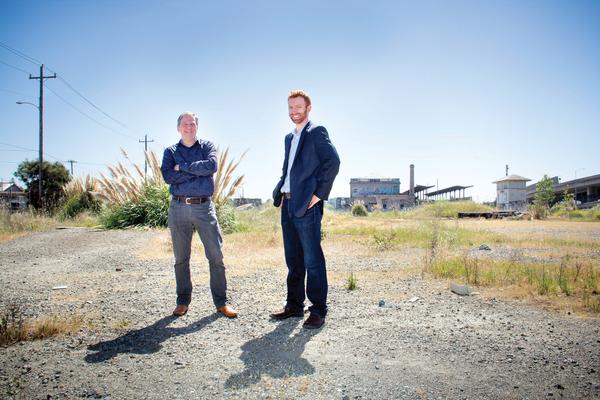West Oakland on track for change
The rough-and-tumble neighborhood has been left out of previous booms, but it’s not going to miss this one
SF Biz Times
by Roland Li
April 24, 2015
Rick Holliday has been interested in West Oakland since he was a city planning student at UC Berkeley in 1975. “Rick, it’s all going to be West Oakland,” he remembers a professor telling him then about the hardscrabble area in the shadow of the elevated Cypress Freeway. “It’s minutes away from San Francisco. The land’s accessible.”
Developer Holliday, 61, counts five real estate booms and busts in the 40 years since, and through them all West Oakland has lagged behind. It has remained pockmarked with vacant or abandoned lots, plagued by deprivation and crime and largely left out of Oakland’s regeneration.
Now, the neighborhood seems poised to join the Bay Area development frenzy. Drawn by its location halfway between downtown San Francisco and downtown Oakland, multiple developers have recently completed or are planning more than 1,000 units, suddenly turning West Oakland into one of the city’s most active building zones.
For more information on the changing landscape in Oakland sign up for our free daily newsletters.
“West Oakland didn’t become interesting to this regional market until this cycle,” said Holliday, who paid $15 million for 29 acres around the historic Pacific Railroad station at 16th and Wood streets in 2000. “It missed every other one.”
Holliday built 163 for-sale homes at Pacific Cannery Lofts, a renovated industrial space at 1201 Pine St., in 2008. Next door, Pulte Homes has now completed the 130-unit Zephyr Gate. Bridge Housing has built 99 affordable units in a project called Ironhorse and has more in the works.
“It’s one of the most attractive places to build,” said Adhi Nagraj, senior project manager at Bridge Housing. “It’s also one of the most historically important and culturally important places in the Bay Area.”
Bridge Housing is working with Orton Development Co. to refurbish the old train station. Deteriorated and marked with graffiti, it has been the target of a succession of renovation proposals over the last two decades that have failed to materialize. The goal is to make it a community destination, but plans are still in flux, said Nagraj.
Developer City Ventures will also break ground on 171 for-sale townhouses next to the train station this year.
“The challenge and the goal of West Oakland is helping it develop while preserving its character and culture,” said City Ventures CEO Philip Kerr. “I see West Oakland as one of the best places to invest in the Bay Area right now. It’s got a tremendous amount of character, a tremendous amount of soul.”
The developers are betting on one of the neighborhood’s biggest assets: location. From the West Oakland BART station, it is six minutes to San Francisco’s Embarcadero station, and four minutes to the City Center station in downtown Oakland.
Oakland’s only market-rate housing project in 2014 was in West Oakland: Madison Park Financial’s Lampwork Lofts, a 92-unit renovation of a former lightbulb factory. The project was fully leased in three months.
Madison Park is moving forward this year with two more projects in the West Oakland area: 47 units at 2868 Hannah St. and 120 units at 3250 Hollis St. John Protopappas, founder and CEO, sees plenty of room for developers to add housing.
“We have sites that are zoned for more intense use that are being underutilized,” said Protopappas, who also lives in West Oakland. “It’s going to take years to fill in these spaces.”
Meanwhile, the city also passed the West Oakland Specific Plan last year, which anticipates 22,000 new jobs in the area and close to 5,000 new residential units around the BART station and other large “opportunity sites.”
Despite its desirable location, West Oakland has resisted change even as businesses have moved into nearby areas. Rooms in the neighborhood’s Victorian-style homes can be rented for less than $1,000 a month, a rarity in the Bay Area. Much of that is tied to the neighborhood’s history of destruction and isolation.
West Oakland was cut off from its neighbors in the 1950s by the elevated Cypress Freeway and BART tracks. The development of a giant post office and public housing projects gutted a lively commercial strip. The 1989 earthquake collapsed the upper deck of the Cypress Freeway, killing 42 people beneath it. The city tore the rest to ground level, renamed it Mandela Parkway and added a swathe of green space between traffic lanes.
West Oakland was also the center of activity for the revolutionary Black Panther Party in the 1960s.
Although there has been economic progress and revitalization in more recent decades, crime is still a problem. In Oakland’s Police District One, which includes West Oakland and parts of downtown, overall crime has been flat over the last three years. But burglaries more than doubled to 2,573 in 2014 from 1,241 in 2011. One of the most visible incidents of violent crime came in March, when Chyemil Pierce, 30, was fatally shot trying to shield her children from gunfire on Chestnut Street.
“It’s a perception challenge that has to be dealt with. But by no means is it something that’s insurmountable,” said Kevin Brown of Holliday Development, referring to crime.
Another big challenge is the lack of restaurants and retail, which reduces visitors and draws spending out of the area. The neighborhood still has no full-service grocery store, but one is planned to open at Jack London Gateway by 2016. Developers see density as the solution. “With more housing, the retail inevitably flows,” said Protopappas.
Entrepreneurs are also trying to expand retail options – but not without some pushback (see accompanying story at right).
Holliday, the West Oakland pioneer who estimates he lost $20 million on Pacific Cannery Lofts, is sticking with the neighborhood. He has a 235-unit rental building that will break ground this year at the northern end of the train station site.
“West Oakland is probably the best area in the Bay Area now, because the rest has filled out,” he said. “The next 10 years here are really going to be significant.”
‘Our political agenda: If you want coffee, we’ll sell it to you’
Ethan Ashley opened Kilovolt Coffee at 1829 Mandela Parkway last spring after noticing nearby workers had to travel to Emeryville for their caffeine fix.
Ashley raised $130,000 in funding from friends and the San Francisco restaurant Mission Pie to finance the shop. It has been a hit, serving hundreds of customers each day and employing nine people.
But it has also drawn vandals, who threw rocks through the windows and sprayed graffiti labeling the store and its customers as “yuppies.”
Ashley suspects that the backlash is from people who don’t even live in the area and are misplacing their anger, and he doesn’t see the violence as indicative of the neighborhood. “This is not a Starbucks. This is an independent coffee shop,” he said. “This is all our political agenda is: If you want coffee, we’ll sell it to you.”
“The crime thing is overhyped,” he added. “Cars are broken into in San Francisco. There’s just nicer restaurants.”
Kilovolt’s success follows that of Brown Sugar Kitchen, a popular restaurant known for its chicken and waffles that opened in 2008. “People are taking a risk because we took a risk,” said Tanya Holland, owner of Brown Sugar Kitchen.
Across the street from Kilovolt is one of West Oakland’s biggest industrial facilities: American Steel Studios.
After looking for a place to store her own sculptures, which were featured at Burning Man, artist Karen Cusolito discovered the property around 2005. She signed a master lease and has filled the six-acre property with more than 180 artists, woodworkers and steel welders.
One tenant, Lara Edge, an owner of Sheet Metal Alchemist, is concerned that more housing and rising rents will eventually force businesses out of West Oakland.
But she notes that the relationship between investment and displacement is a complex one, and that so-called gentrification can also lead to prosperity.
”It’s not so simple about money moving in, and people getting kicked out,” said Edge. “If that market didn’t exist, our business wouldn’t exist. It’s all interrelated.”



